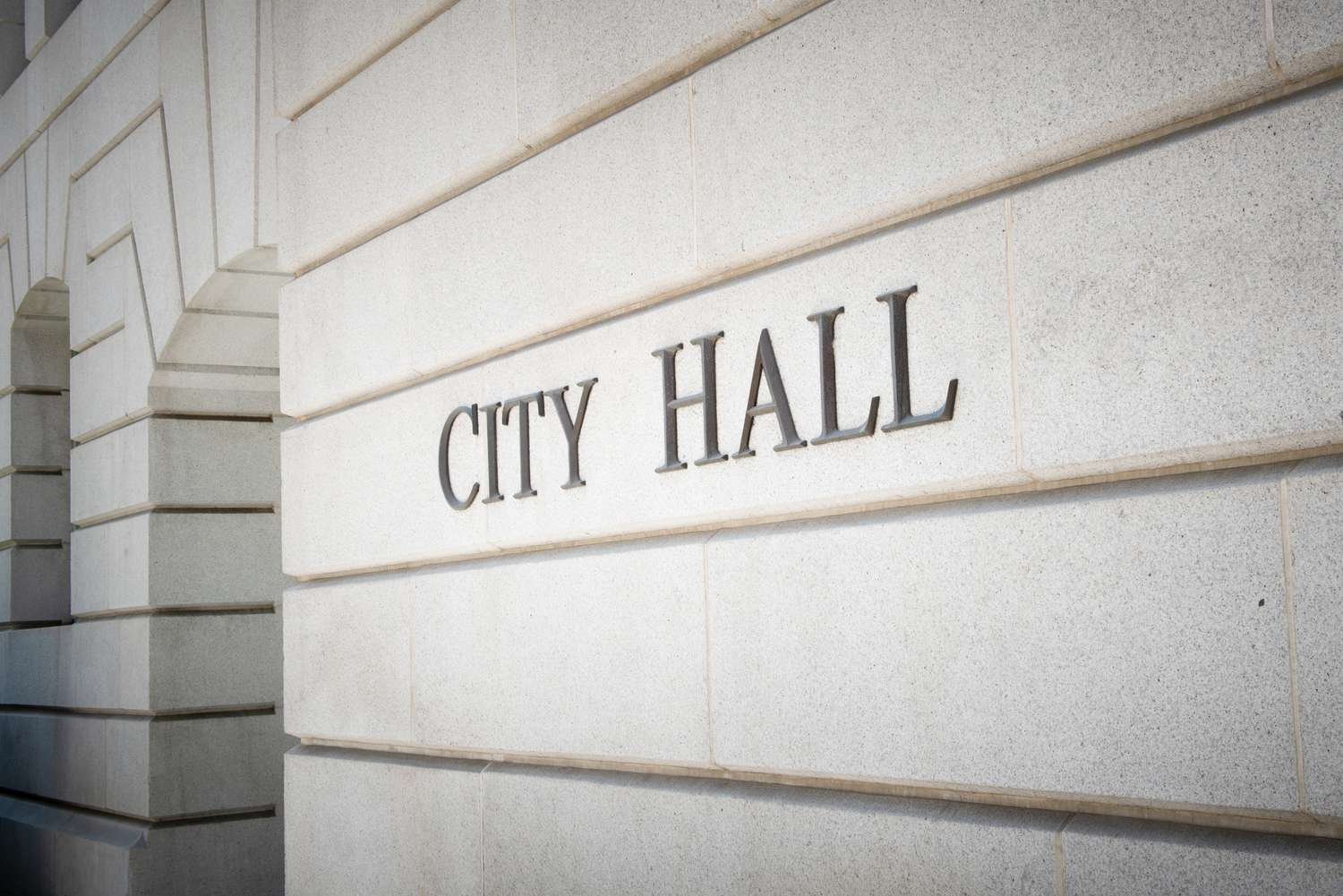What Is Public Administration?

Shutterjack / Getty Images
:max_bytes(150000):strip_icc():format(jpeg)/GettyImages-1327439280-ab205979f9ca4834b9d790934d778405.jpg)
Public administration is a field of governance in which leaders serve communities to advance the common good and effect positive change. Public administration professionals work in local, state, and federal government as well as nonprofit organizations. In general, the field of public administration is responsible for determining the policies and programs of governments. Specifically, it is the planning, organizing, directing, coordinating, and controlling of government operations.
Key Takeaways: Public Administration
- Public administration is the day-to-day interface between the government and the citizens.
- It can be thought of as the transformation of politics into the reality that the average citizen sees every day.
- The goal of public administration is to keep the various components of a government agency operating in an effective, economically efficient manner
- Public administration is responsible for determining the policies and programs of governments.
- Public administration professionals work in local, state, and federal government.
History and Definitions
The concept of organized public administration dates back to the 8th and 7th centuries BCE. During this “Antiquity Era,” the kings, pharaohs, and emperors that ruled Ancient Greece chose citizens to act as their “eyes and ears” for public affairs.
Around 400 BCE, democracy emerged in Greece after the scholars of Plato’s Academy paved the way for a Greek empire that chose its leaders based on the opinion of the people. This naturally led to politicians campaigning to the people, which further developed the public administration atmosphere.
Some ten centuries later, around 1525, Italian politician and philosopher Niccoló Machiavelli began organizing public administration into an actual government position. Instead of loosely assigning citizens serving as public reporters, Machiavelli proposed a cohesive, organized public administration system with government groups who dedicated themselves to functional administrative roles.
The modern field of public administration is said to have begun in 1887, when Woodrow Wilson, then a professor at Bryn Mawr College, wrote his famed essay, “The Study of Administration.” The essay highlights certain aspects of the administrative process and earns Wilson the title “Father of Public Administration.” Among other points discussed, Wilson’s essay covers the separation of administration and politics as well as ways to improve the public service sector by training qualified civil servants.
The 28th President of the United States Woodrow Wilson. âFather of Public Administration.â.
Tony Essex / Getty Images
As president, Wilson instituted his ‘merit-based’ system of hiring, which represented a sea change to national public administration that helped the U.S. bureaucracy become more efficient. Wilson developed the idea that politicians should create policies, while administrators should help implement them. This theory is known as the “policy/administration dichotomy.” This idea from Wilson, along with his belief that the nation’s administration should run like a business, dramatically changed the way government functioned during his presidency and beyond.
Before this idea, workers in the U.S. government’s administration were typically hired based on their loyalty to a political party, literally “who” they knew rather than “what” they knew. As president Wilson instituted his ‘merit-based’ system of hiring, which represented a sea change to national public administration.
After World War II, society as a whole began to feel that the current public administration system was ineffective. As a result, the idea of public administration expanded to include analysis and policy-making practices throughout all levels of government. Instead of focusing strictly on the bureaucratic side of public administration, the new policy-making practices set forth would concentrate on the public sector. This led to the need for top-level public administrators to include psychology, anthropology, and other social sciences in their skill sets.
As a subfield of political science, public administration can generally be thought of as the transformation of the whims and uncertainties of politics into the reality that the average citizen sees every day. In a narrower sense, it is a diverse field of study and practice whose fundamental goal is to advance management and policies so that government can best function to provide for the “common good”—those facilities or institutions that benefit all members of a given community. Examples of elements making up the common good include police and fire departments, roads and highways, public utilities, and well-planned communities.
The concept of public administration emerges from the concept that in all areas of social, economic, and political life there is an administration which means that for the proper functioning of the organization or institution it must be properly ruled or managed.
The U.N. Committee of Experts on Public Administration has stated that public administration is “centrally concerned with the organization of government policies and programs as well as the behavior of usually non-elected officials formally responsible for their conduct.” Many non-elected public employees can be considered to be public administrators, including heads of city, county, regional, state, and federal departments such as city managers, budget and planning directors, human resources administrators, chiefs of police, fire marshals, and cabinet secretaries. Public administrators are public employees working in public departments and agencies at all levels of government.
At all levels of government, however, public administrators coordinate select government operations and their associated policies in various stages of the policy cycle. These stages include planning, implementing, executing, and monitoring the policies to ensure that they can achieve the intended goals with maximum effectiveness.
To do this, public administrators take a hands-on approach to the elements that make up the policy. They must be able to work with other agency officials to ensure effective policy development, implementation, and execution. They also need the financial savvy to track budgets and coordinate project spending appropriately.
Public administrators may also take on advocacy roles, developing strategies that encourage communities and their residents to utilize the services these policies and plans provide. This often requires them to interface directly with the public to explain policies and regulations.
Ultimately, the goal of public administration is to keep the various components of a government agency operating in an effective, economically efficient manner. By developing new policies and overseeing the fair and efficient execution of existing ones, public administration plays a key role in assuring that the government works as intended for the citizens it serves.
Areas of Study
Both the study and practice of the field of public administration consist of several sub-fields. Six of the most easily recognized of these are organizational theory, ethics, policy analysis, public budgeting and financing, urban planning, and human resource management.
City planning department employees discuss a development proposal.
10’000 Hours / Getty Images
Organizational Theory
Organizational theory in public administration is the study of the structure of governmental entities and the many particulars ingrained in them. The theory involves a set of related concepts that explain how individuals behave in organizations. The organizational theory also attempts to explain how interrelated units of organizations do or do not connect. It also strives to explain how groups of individuals behave, which may differ from the behavior of individuals. In public administration, organizational theory often focuses on motivating goal-directed behavior.
Ethics
Ethics in public administration serves as a standardized approach to decision-making. Usually considered a branch of political science, ethics in the public sector addresses the fundamental premise of the public administrator’s duty as a responsible and responsive “steward” to the public. In general, ethics in public administration is the moral justification and consideration for decisions made and actions taken during the completion of daily duties when working to provide the general services of government. Ethics are an accountability standard by which the public will judge the work being conducted by the public administrators of the organization. Ethics also places an additional burden upon public administrators regarding the conduct of their personal lives. Finally, public sector ethics is an attempt to create a more transparent atmosphere within governmental operations.
Policy Analysis
Policy analysis serves as an empirical approach to decision-making. In public administration, it is used to enable civil servants, activists, and others to examine and evaluate the available options to implement the goals of laws and elected officials. It has been defined as the process of “determining which of various policies will achieve a given set of goals in light of the relations between the policies and the goals.”
Public Budgeting
Public budgeting is the activity within a government that seeks to allocate limited resources among unlimited demands. According to public choice theory, politicians see the budget process as “a political event conducted in the political arena for political advantage.” Economists, on the other hand, view budgeting as a matter of allocating resources in terms of opportunity cost where allocating resources to one group of citizens takes resources away from another group of citizens.
Urban Planning
Urban planner examining architectural model in office.
Resolution Productions / Getty Images
Perhaps the most visible practice in the field of public administration, urban planning is the technical and political process focused on the development and design of land use and the built environment. Urban planners must consider factors including air, water, and the infrastructure passing into and out of urban areas, such as transportation, communications, and distribution networks, and their accessibility. It further involves the design and regulation of the uses of space that focus on the physical form, economic functions, and social impacts of the urban environment and the location of different activities within it. Urban planning also must be responsive to engineering, architectural, economic, social, and political concerns.
Human Resource Management
Human resource management strives to ensure an in-house structure that ensures that public service staffing is done in an unbiased, ethical and values-based manner. The basic functions of the human resource system are employee benefits, employee health care, compensation, and many more, including human rights, and the Americans with Disabilities Act as it relates to hiring practices. The executives including the human resources director and other key departmental personnel are also part of the public administration system.
Theoretical Overview
Public administration theory is the realm in which discussions of the meaning and purpose of government, the role of bureaucracy in supporting democratic governments, budgets, governance, and public affairs takes place.
Since Woodrow Wilson wrote “The Study of Administration” in 1887, three different common theories of public administration have evolved: Classical Public Administration Theory, New Public Management Theory, and Postmodern Public Administration Theory. Each offers a different perspective on how administrators should practice public administration.
Classical Public Administration Theory
Often associated with Woodrow Wilson, Classical Public Administration Theory stresses efficiency in organizational work. Wilson promoted ideas like merit-based promotions, professionalization, a non-political system, and a pragmatic (rather than sympathetic) bureaucracy. The command structure is designed to manifest both the overall objectives of the organization as well as the specific purposes of the functional units. . Although the classical system stresses structure over everything else, the basic issue is efficiency in communication. This requires certain things to be in place: a strict definition of duties and objectives, control over all labor functions, and a rational connection of one functional unit to another. Without these basics, no organization can function efficiently, according to classical theory.
New Public Management Theory
Developed during the 1980s, the New Public Management Theory was part of an effort to make the public service more “businesslike” and to improve its efficiency by using private sector management models. Recognizing citizens as the customers of the public sector, advocates of New Public Management Theory experimented with using decentralized service delivery models, to give local agencies more freedom in how they delivered programs or services to citizens. Advocates aim to replace the academic, moral, or disciplinary emphasis of traditional public administration with a professional focus.
New Public Management Theory saw the introduction of online e-government allowing the consolidation of programs and services to a central location to reduce costs. Key themes in New Public Management were “financial control, value for money, increasing efficiency, identifying and setting targets, continual monitoring of performance, and handing over power to the senior management executives. Performance was assessed with audits, benchmarks, and performance evaluations. New Public Management also ushered in the use of private sector companies to deliver services formerly delivered only by the government.
NPM advocates aim to replace the academic, moral, or disciplinary emphasis of traditional public administration with a professional focus.
Postmodern Public Administration Theory
Linked to the capitalist model of the late 20th and 21st century, Postmodern Public Administration refers to the inner workings of nearly every government entity in existence. Whether it is the members of the U.S. Congress or employees of a city planning department processing the paperwork of applicants hoping to develop tracts of land. Postmodern public administration encompasses all government positions that affect the public. Since the 1980s the classical theory model of public administration has been largely rejected by governments in favor of a more focused managerial model based on private sector practice, within the context of a market-based economic model of public organization.
Public Administration in Academia
Education in public administration has an interesting history rooted in numerous other scholarly disciplines, such as sociology, political science, economics, and engineering. Today, however, many universities offer degree programs specifically preparing students for careers in public administration. Typically, typically they offer the Master of Public Administration (MPA) degree, although in some universities, a Master of Arts (MA) in Public Administration is awarded. Other universities offer undergraduate level Bachelor’s degrees such as a Bachelor of Science in Public Administration as well as Bachelor of Arts in Government, Political Science, and International Affairs with an academic concentration or specialization in Public Policy and Administration.
In the United States, the academic field of public administration draws heavily on political science and administrative law. Typically, public administration programs cover public policy management, legislative relations, public budgetary processes, financial management, labor relations, and ethics.
The MPA programs prepare students to enter or advance their careers through the study of government and nonprofit decision-making and policy implementation. The National Center for Education Statistics (NCES) defines it as a branch of study that prepares students to serve as a public service manager in local, state, or federal government An MPA prepares students to become competent leaders through coursework that involves high-level knowledge and understanding of human resource management, communication skills, budget/financial management, law, data analysis, and theory as it relates to the public sector.
As in other fields, training in public administration also takes place “on the job,” as lower-level employees learn from their degreed supervisors. Many entry-level employees in public administration agencies go on to earn a Master of Public Administration degree as a pathway to career advancement.
Sources
- Wilson, Woodrow V. (1887). “Study of Public Administration.” Forgotten Books, August 24, 2018, ISBN-10: 331046815.
- Holzer, Marc. “Public Administration: An Introduction.” Routledge, August 2019, ISBN-10: 1138579661.
- Frederickson, H. George. “The Public Administration Theory Primer.” Routledge, July 28, 2015, ISBN-10: 0813349664.
- Johnson, William C. “Public Administration: Partnerships in Public Service.” Waveland Press, April 1, 2014, ISBN-10: 1478610905.
- Kettl, Donald F. “Politics of the Administrative Process.” CQ Press, January 17, 2020, ISBN-10: 1544374348.



